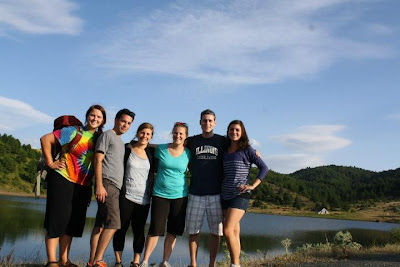I recently saw this idea on another PCV's blog and thought it might be fun to try. I realize that so far I've focused more on my personal experiences, telling stories about the adventures I've had or projects I've worked on, but I haven't talked to much about how life works here in Gramsh. I guess that since I live here now the every day things don't seem that different to me, thus I haven't felt the need to share them. But with my mom's recent visit I realized that it is these little things that make my life here SO different from my life in the states. From now on I'll try to post one of these once a month in an attempt to explain the everyday.
For now lets begin with my favorite days of the week...market days!! Every Wednesday and Saturday I wake up to a Gramsh that looks completely different. People are out on the streets, cars are everywhere and there are some extra donkeys walking by my window. As the regional hub, Gramsh has the biggest market and villagers come from as far as an hour away just to sell their crops, buy food for the week or socialize. The market is divided into two main sections, one for food and one for clothes.
Lets begin with food! The food area is divided into two as well, an open area for fruits and veggies and a covered building for eggs, spices and dairy. We'll assume that you're approaching the market from the town center (thats how you get there from my house), in which case you'll enter the covered egg and dairy section first. I like to think of this area as the light version of the market. It is always less hectic, less crowded and less noisy.
NOTE: People don't usually stare at you with a "What in the world are you doing?" look at the market unless you're like me and snapping pictures of them.
 |
| Here is your standard egg stand. |
 |
| Thats right...there is a room of cheese, just cheese. |
If you follow the light at the end of the tunnel, you'll be taken to my own personal heaven here in Gramsh...the fruits and vegetables. Now I am lucky enough to come from a town that loves its Farmers Market, but the market here still blows me away every time. Between the vendors set up on the cement tables in the center and those who simply set up shop on the ground, there are easily 40-50 different stands to choose from. It is definitely more crowded and hectic than the inside area but don't be intimidated. I like to begin by taking a lap around the area to check out prices and who has the best looking goods, although I've recently chosen an onion guy who I always buy my onions from. I find that if you always go back to the same vendors, they throw in a little extra after you've paid. (Free food!!)
 |
This is what it'll look like from the outskirts. Just be careful not to
accidentally step on anyone's stand. |
 |
| A typical stand in the center area. |
 |
| An example of one of the makeshift stands around the outside. |
Now you're probably wondering how one goes about actually buying things here.
Step 1: Work up the courage to actually approach a stand. (I typically have to do a lap around the market before I get to this point so don't be ashamed.)
Step 2: Make small talk with the seller. Asking questions about what village they're from, when whatever they're selling came into season or the always trust worthy, tell me about your kids work.
Step 3: If there is no makeshift sign by whatever you're looking to buy letting you know the price, ask!
Step 4: Tell them how much you want. (Warning: Anything less than a kilo will get you a "you must be crazy" look.)
Step 5: Fill the standard blue plastic bag that they hand you with however much you think you want.
Step 6: Watch as they weigh your purchase and probably through in a few more because obviously you meant to buy more than 5 apples even though you live alone.
Step 7: Pay. And you're done.
As for prices, an egg will cost you either 9 or 10 leke or $0.10 and a 1/4 kilo of white cheese (think of feta) will be around 250 leke or $2.50. Fruits and vegetables change with the seasons but on my most recent trip I got a kilo of onions for 40 leke, a kilo of apples for 50 leke and a kilo of cucumbers for 50 leke all for a total of 140 leke or $1.40. Tomatoes right now will cost you 80-100 leke or around $1 for a kilo but earlier in the summer they were down to 60 leke or an amazing $0.60. As you can see, with prices like that there is no excuse not to eat fresh produce at most meals, especially when you live off of $5.00 a day.
In an effort to not scare you away with how long this post is and to get around my slow internet, check out part 2 for the clothes!

























